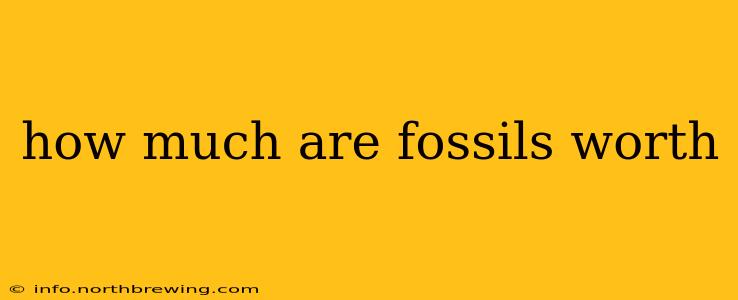The value of a fossil is incredibly variable, ranging from a few dollars to millions. It's not a simple question with a simple answer; many factors influence a fossil's worth. This guide will delve into those factors, helping you understand what makes a fossil valuable and how to assess its potential worth.
What Factors Determine a Fossil's Value?
Several key elements contribute to a fossil's financial worth:
-
Rarity: The rarer the fossil, the higher its value. A complete skeleton of a Tyrannosaurus Rex is far more valuable than a common trilobite, simply due to its scarcity. Even within a species, the completeness and condition of a specimen impact rarity.
-
Species/Genus: Certain species are inherently more desirable than others. Iconic dinosaurs like T. rex and Triceratops command significantly higher prices than less-recognizable species. Similarly, well-known prehistoric mammals like mammoths or saber-toothed cats hold substantial value.
-
Completeness and Condition: A complete and well-preserved fossil is worth far more than a fragmented or damaged one. The level of preservation, including the presence of original bone or shell material, significantly impacts value. Fossils with exceptional detail, such as skin impressions or feather imprints, are highly sought after.
-
Scientific Significance: Fossils that offer crucial insights into evolutionary history or paleoecological understanding are highly valued, often exceeding their monetary worth due to their scientific importance. These fossils are often sought after by museums and research institutions.
-
Provenance (Origin and History): Knowing the fossil's exact location of discovery and its subsequent history adds to its value. A fossil with a well-documented provenance – showing clear ownership and handling – inspires greater confidence and trust among buyers.
-
Preparation and Presentation: The quality of fossil preparation—the cleaning and restoration—is a critical factor. Skilled preparation can dramatically enhance a fossil's aesthetic appeal and thus its value. The way the fossil is presented (e.g., in a custom-made mount) also impacts its desirability.
-
Market Demand: Like any collectible item, current market demand plays a significant role. Popular species or those featured in media (movies, documentaries) can experience increased demand, driving up their prices.
-
Size: Larger and more impressive specimens often command higher prices, particularly for complete skeletons.
How Much Do Specific Fossils Typically Sell For?
It's difficult to give exact figures, as fossil prices are not standardized and vary widely based on the factors mentioned above. However, to provide some context:
-
Common Fossils (e.g., ammonites, trilobites): These can range from a few dollars to a few hundred dollars, depending on size, condition, and presentation.
-
Vertebrate Fossils (e.g., dinosaur teeth, smaller bones): Can range from tens of dollars to thousands, depending on the species, completeness, and condition.
-
Rare and Complete Skeletons (e.g., T. Rex): These can fetch millions of dollars at auction.
How Can I Find Out the Value of My Fossil?
Determining the value of your fossil requires expertise. Here's how you can approach it:
-
Consult with Paleontologists or Fossil Dealers: Experts can assess your fossil based on the factors listed above. Their expertise ensures a fair and accurate valuation. Be cautious of online appraisal websites; in-person examination is often crucial.
-
Research Similar Fossils: Look at auction results and fossil sales records to get an idea of the market value of comparable specimens.
-
Consider Professional Appraisal: For valuable fossils, a formal appraisal from a reputable appraiser might be necessary for insurance purposes or legal transactions.
What are Some Common Fossil Types and Their Approximate Value Ranges?
This is a broad generalization and should only be considered a starting point:
- Ammonites: $10 - $1000+ (depending on size, preservation, and rarity)
- Trilobites: $20 - $500+ (depending on completeness and species)
- Dinosaur Teeth: $50 - $10,000+ (depending on species, size, and condition)
- Fossil Plants: $10 - $1000+ (depending on species, preservation, and size)
- Shark Teeth (e.g., Megalodon): $20 - $1000+ (depending on size and condition)
Remember: These are very rough estimates. The actual value can vary significantly based on the factors discussed above.
In conclusion, determining the value of a fossil is a complex process requiring expertise and careful consideration of multiple factors. Always consult with professionals for accurate valuations, especially for significant or rare specimens.
